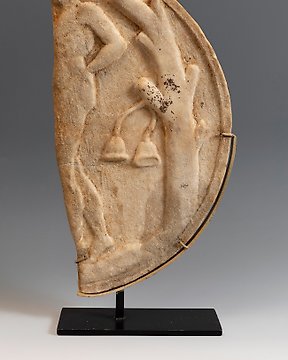
Oud-Romeins Marmer Oscillum-fragment. 1e - 2e eeuw na Christus. Hoogte 38 cm.
Nr. 84074761

Nr. 84074761

theatrical mask.
Roman Empire, 1st century B.C. - 2nd century AD.
Material: Marble.
Provenance: Private Collection of Bengt Söderbergh (1925-2019), Cannes, France.
Without restorations.
Measures: 29 x 20 cm.
Theater mask with markedly archaic features, an aspect appreciable in the large almond-shaped eyes, in the hieratism of the face and in the headdress that the personage wears. The ethnologists place the birth of the mask in the moment in which the self-consciousness is produced. Its use dates back to the most distant antiquity, being found among the Egyptians, Greeks and Romans. The Greeks used them in the Dionysian festivities; the Romans during the Lupercal and Saturnalia and also in the scenic representations.
The Romans brought two important innovations to the world of sculpture: the portrait and the historical relief, neither of which existed in the Greek world. However, they followed the Greek models for a large part of their sculptural production, a base that in Rome was combined with the Etruscan tradition. After the first contacts with the Greece of classicism through the colonies of Magna Graecia, the Romans conquered Syracuse in 212 BC, a rich and important Greek colony located in Sicily, adorned with a large number of Hellenistic works. The city was sacked and its artistic treasures taken to Rome, where the new style of these works soon replaced the Etruscan-Roman tradition that had prevailed until then. Cato himself denounced the sacking and decoration of Rome with Hellenistic works, which he considered a dangerous influence on native culture, and deplored the Romans' applauding of statues from Corinth and Athens, while ridiculing the decorative terracotta tradition of ancient Roman temples. However, these oppositional reactions were in vain; Greek art had subdued Etruscan-Roman art in general, to the point that Greek statues were among the most coveted prizes of war, being displayed during the triumphal procession of the conquering generals.
NOTES:
- The piece includes authenticity certificate.
- The piece includes Spanish Export License.
- The seller guarantees that he acquired this piece according to all national and international laws related to the ownership of cultural property. Provenance statement seen by Catawiki.
THE MINISTRY OF CULTURE FROM SPAIN ASKS ALL SELLERS FOR INVOICES OR OTHER DOCUMENTATION ABLE TO PROVE THE LEGALITY OF EACH ITEM BEFORE PROVIDING AN IMPORT OR EXPORT LICENSE.
#ancientcivilisations
Zo koop je op Catawiki
1. Ontdek iets bijzonders
2. Plaats het hoogste bod
3. Veilig betalen